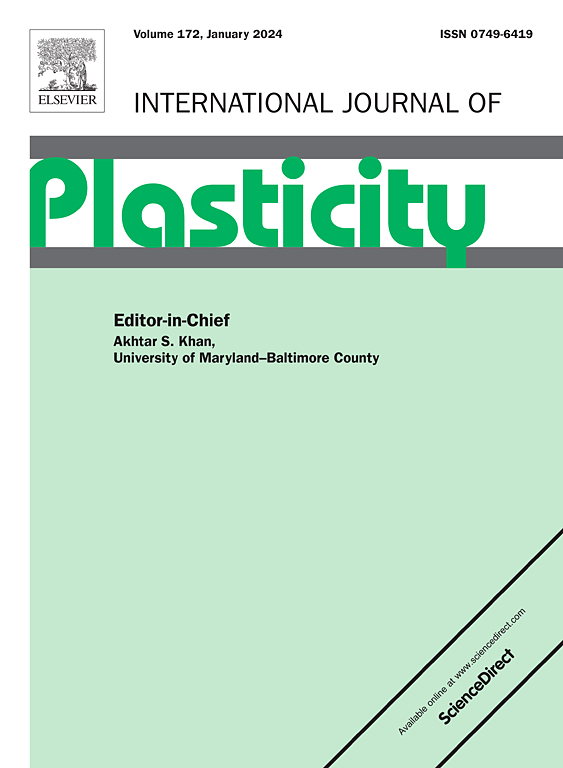Hydrogen and hydride induced stress localization in single phase HCP and dual phase HCP-BCC alloys
IF 12.8
1区 材料科学
Q1 ENGINEERING, MECHANICAL
引用次数: 0
Abstract
Hydrogen partitioning and hydride-induced stress localization are important factors in the degradation of dual-phase alloys. This study investigates these mechanisms by developing a crystal plasticity finite element (CPFE) model that incorporates the two-way interaction between stress and hydrogen concentration. The model considers the effects of hydrogen-induced lattice expansion (HILE), phase-dependent hydrogen partitioning, and the transformation strain induced by hydride precipitation. Using this model, the impact of hydrogen on stress distribution and hydride precipitation is examined both in single and dual-phase zirconium alloys with hexagonal close-packed (HCP) and body-centered cubic (BCC) crystals. The results of the model for hydride precipitation are compared with those measured by high-spatial resolution electron backscatter diffraction (EBSD). The findings reveal that HILE effects are more pronounced in dual-phase HCP-BCC alloys due to partitioning of hydrogen between phases. The nonuniform distribution of hydrogen atoms leads to stress localization, which creates favorable conditions for hydride nucleation, particularly near the HCP-BCC interfaces. It is shown that the proposed numerical framework can identify which one of the neighboring HCP grains is the corresponding parent grain of an intergranular hydride.


氢和氢化物诱导的单相HCP和双相HCP- bcc合金的应力局部化
氢分配和氢化物引起的应力局部化是双相合金降解的重要因素。本研究通过建立一个晶体塑性有限元(CPFE)模型来研究这些机制,该模型包含了应力和氢浓度之间的双向相互作用。该模型考虑了氢诱导晶格膨胀 (HILE)、随相变化的氢分配以及氢化物析出诱导的转化应变的影响。利用该模型,研究了六方紧密堆积(HCP)和体心立方(BCC)晶体的单相和双相锆合金中氢对应力分布和氢化物析出的影响。氢化物析出模型的结果与高空间分辨率电子反向散射衍射 (EBSD) 测量的结果进行了比较。研究结果表明,在双相 HCP-BCC 合金中,由于相间的氢分配,氢化物析出效应更为明显。氢原子的不均匀分布导致应力局部化,为氢化物成核创造了有利条件,尤其是在 HCP-BCC 界面附近。研究表明,所提出的数值框架可以确定相邻 HCP 晶粒中的哪一个是晶间氢化物的相应母晶粒。
本文章由计算机程序翻译,如有差异,请以英文原文为准。
求助全文
约1分钟内获得全文
求助全文
来源期刊

International Journal of Plasticity
工程技术-材料科学:综合
CiteScore
15.30
自引率
26.50%
发文量
256
审稿时长
46 days
期刊介绍:
International Journal of Plasticity aims to present original research encompassing all facets of plastic deformation, damage, and fracture behavior in both isotropic and anisotropic solids. This includes exploring the thermodynamics of plasticity and fracture, continuum theory, and macroscopic as well as microscopic phenomena.
Topics of interest span the plastic behavior of single crystals and polycrystalline metals, ceramics, rocks, soils, composites, nanocrystalline and microelectronics materials, shape memory alloys, ferroelectric ceramics, thin films, and polymers. Additionally, the journal covers plasticity aspects of failure and fracture mechanics. Contributions involving significant experimental, numerical, or theoretical advancements that enhance the understanding of the plastic behavior of solids are particularly valued. Papers addressing the modeling of finite nonlinear elastic deformation, bearing similarities to the modeling of plastic deformation, are also welcomed.
 求助内容:
求助内容: 应助结果提醒方式:
应助结果提醒方式:


